
10 Best Campgrounds for Camping in Yellowstone
Most campgrounds in Yellowstone National Park are now open and soon it will enter the peak season of camping in Yellowstone. Countless visitors are drawn by the park's stunning geological features, landscapes, and wildlife. If you are interested in camping in the park or you’ve already started planning for it, it is necessary to learn more about Yellowstone campgrounds and make thorough preparation in advance. In this post, you’ll find an introduction to the 10 Best Campgrounds in Yellowstone National Park, essentials, and tips for camping in Yellowstone.
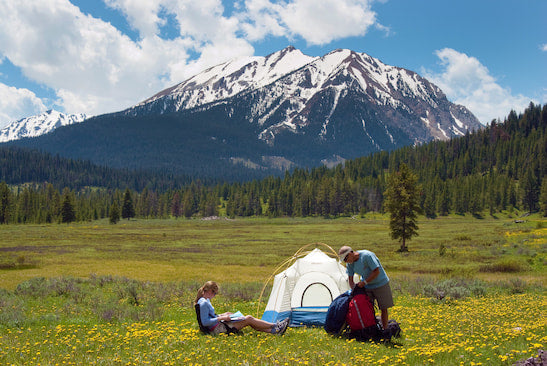
10 Best Campgrounds in Yellowstone National Park
Yellowstone has a large area in which 10 campgrounds are scattered. It is wise to take the surrounding attractions and camp facilities into consideration when picking the best campground for you.
Mammoth Campground
Nearby Attractions: Lamar Valley, Tower-Roosevelt, Beartooth Mountains, Beaver Ponds Loop Trail, the Bunsen Peak Trail.
Sites: 85
Toilet: Flush
Shower/Laundry: Yes
Dump Station: Yes
Generator Permitted: No
Mammoth Campground is a good choice if you want to camp near the northern park entrance.
You can visit the nearby valley or mountains and find several hiking trails here.
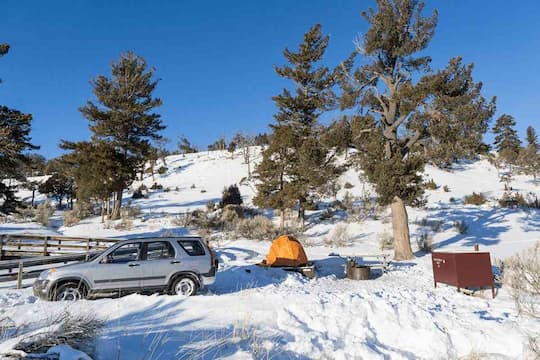
Grant Village Campground
Nearby Attractions: West Thumb Geyser Basin, Old Faithful, Grand Teton National Park, Grant Village Nature Trail, DeLacy Creek Trail.
Sites: 430
Toilet: Flush
Shower/Laundry: None
Dump Station: None
Generator Permitted: None
Grant Village Campground is near the shore of Yellowstone Lake. It is an ideal base for people who want to explore the southern part and who are fond of lakes. It’s located in the middle of Yellowstone and Grand Teton National Park, and it’s not far to drive out from the park to pay another visit to Grand Teton.

Madison Campground
Nearby Attractions: Firehole River, the Gibbon River, the Lower Geyser Basin, the Madison River Trail, the Fairy Falls Trail.
Sites: 278
Toilet: Flush
Shower/Laundry: Yes
Dump Station: None
Generator Permitted: None
Located in the western part of Yellowstone, Madison is best for keen fishers because it has easy access to nearby rivers and basins.
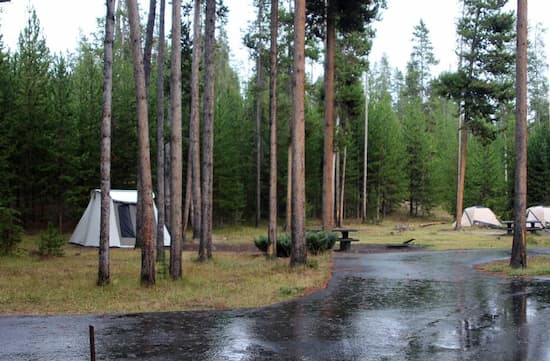
Fishing Bridge RV Park
Recreations: RV camp with full RV amenities
Nearby Attractions: Yellowstone Lake, Hayden Valley, Mud Volcano, Lake Village, Bridge Bay Marina, Fishing Bridge Visitor Center
Sites: 325
Toilet: Flush
Shower/Laundry: None
Dump Station: Yes
Generator Permitted: None
One of the unique features of the Fishing Bridge RV Park is the nearby Bridge Bay Marina, which offers boat rentals and guided fishing trips on Yellowstone Lake. Visitors can also enjoy hiking and wildlife watching in the surrounding area. The campground is also near the Fishing Bridge Visitor Center, which provides information about the park’s history, geology, and wildlife.

Tower Fall Campground
Nearby Attractions: Tower-Roosevelt area, the Lamar Valley, the Beartooth Mountains. the Tower Fall Trail, the Calcite Springs Overlook Trail
Sites: 32
Toilet: Vault
Shower/Laundry: Yes
Dump Station: Yes
Generator Permitted: Yes
Tower Fall Campground is a popular campground located in the northeastern part of Yellowstone National Park. Tents here are operated on a first-come, first-serve basis.
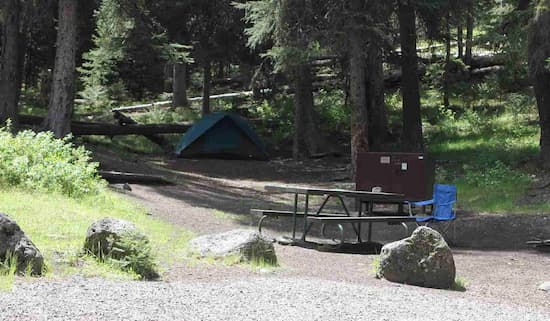
Canyon Campground
Nearby Attractions: Grand Canyon, Hayden Valley, the Upper and Lower Falls, the Uncle Tom's Trail, the North Rim Trail.
Sites: 273
Toilet: Flush
Shower/Laundry: None
Dump Station: None
Generator Permitted: None
Canyon Campground is in the central part of Yellowstone National Park, and it is only a mile from the Grand Canyon. At Canyon Campground, visitors can enjoy a range of outdoor activities, including rock climbing, biking, or water activities like kayaking or swimming, depending on the specific amenities available.
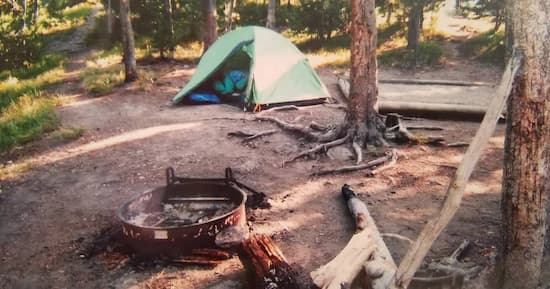
Norris Campground
Nearby Attractions: near the Norris Geyser Basin, Norris Geyser Basin Museum, Gibbon River, the Grand Canyon, the Mammoth Hot Springs, the Back Basin Trail, the Norris Geyser Basin Trail.
Sites: 100+
Toilet: Flush
Shower/Laundry: Yes
Dump Station: Yes
Generator Permitted: None
Norris Campground is in the central part of Yellowstone National Park. The campground provides a convenient base for hikers to embark on various trails and immerse themselves in the natural wonders of the area. With its central location, campers can easily access popular hiking routes.
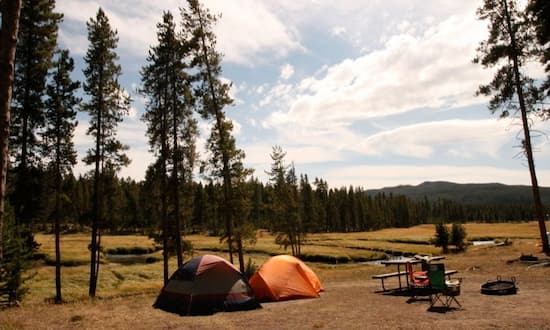
Pebble Creek Campground
Nearby Attractions: the Tower-Roosevelt area, the Beartooth Mountains, the Pebble Creek Trail, the Lamar River Trail.
Sites: 27+
Toilet: Vault
Shower/Laundry: Yes
Dump Station: Yes
Generator Permitted: Yes
Living at the Pebble Creek Campground, it is easy for you to explore the northeast part of the park where there are many mountains and valleys. People who want to watch wild animals in Lamar Valley are recommended to choose this campground.
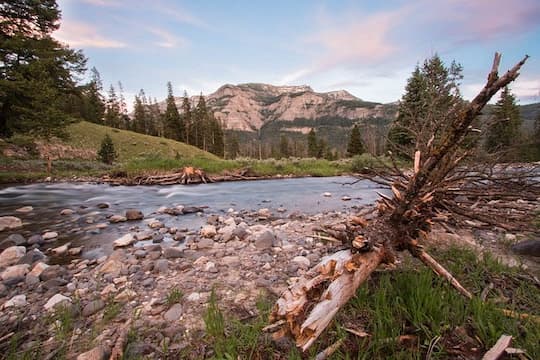
Lewis Lake Campground
Nearby Attractions: West Thumb Geyser Basin, Old Faithful, Grand Teton National Park. Lewis River Channel Trail, Dogshead Loop Trail, Lewis Lake boat ramp, the Lewis Lake picnic area
Sites: 85
Toilet: Vault
Shower/Laundry: Yes
Dump Station: Yes
Generator Permitted: Yes
Lewis Lake Campground is located right between Yellowstone and Grand Teton, and it is the nearest campground to the west entrance. Lewis Lake Campground offers a diverse range of activities to cater to outdoor enthusiasts. Visitors can engage in hiking, biking, camping, wildlife viewing, photography, backpacking, fishing, boating, canoeing, kayaking, and more.

Bridge Bay Campground
Nearby Attractions: Yellowstone Lake, Thumb Geyser Basin, Fishing Bridge, Natural Bridge Trail, Elephant Back Loop Trail, Pelican Creek Nature Trail
Sites: 400+
Toilet: Flush
Shower/Laundry: Yes
Dump Station: None
Generator Permitted: None
Basing on the northwest shore of Yellowlake, Bridge Bay Campground is a great place for outdoor enthusiasts seeking fishing, boating, and a range of other activities.
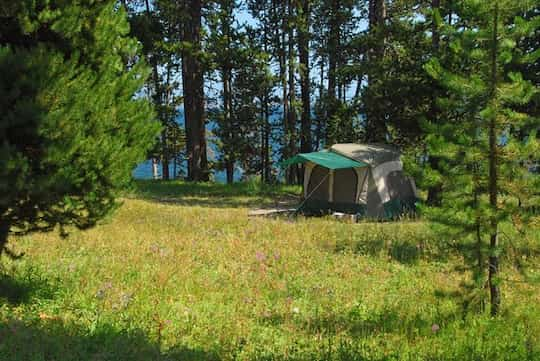
Camping in Yellowstone National Park Essentials
For camping in Yellowstone, it is essential to bring some items that will ensure you are prepared and comfortable during your stay.
- Tent
A tent provides you with shelter, privacy, and protection from bad weather and potential dangers. What kind of tent to choose mainly depends on when you like to travel. For such changeable and uncertain weather in Yellowstone, with temperatures that fluctuate greatly between day and night, four-season tents are recommended.
- Sleeping bag
Sleeping bags keep you warm and comfortable at night. Select sleeping bags according to the nighttime temperature of the camping location. Visitors camping in Yellowstone National Park are advised to choose a warmer sleeping bag that is suitable for below-zero temperatures. It is important that the sleeping bag fits your body properly to avoid large interior space left. The sides of head should be well covered to prevent cold air from entering.
- Sleeping pad
A sleeping pad will provide insulation between you and the ground, preventing ground moisture from entering the tent and making your sleeping experience more comfortable. What’s more, it is used directly on the ground to prevent the tent floor from getting dirty or being scratched by the stone or branches on the ground. After all, it is much easier to wash the pad than to wash the tent.
- Cooking equipment or Convenience foods
Camping stoves or portable grills, pots, pans, and utensils are all common in camping. You may make your choice depending on your own preference. Convenient food is also a good choice that saves a lot of time and energy. It is noteworthy that there are restaurants in Yellowstone National Park and Foods there are provided at reasonable prices.
- Water
Staying hydrated and healthy during your camping trip is crucial, especially if you are engaging in physical activities such as hiking or biking. Bring sufficient water for drinking, cooking, and cleaning. Make sure it is enough for the duration of your trip. It is advised to store water properly in a clean, sealed container to prevent contamination. Remember to bring a water filter or purification tablets if you plan to acquire drinking water from natural sources such as lakes or streams.
- First-aid kit
A first-aid kit should be prepared for any minor accidents or injuries that may occur. It should include essential medical supplies such as adhesive bandages, gauze pads, scissors, antiseptic wipes or sprays, pain relievers, disposable gloves, and sunscreen. It's also important to include any personal medications or prescriptions that you may need. Make sure to check your first-aid kit regularly and restock any items that have been used up or are expired.
- Insect repellent
Insects such as mosquitoes and flies can carry diseases that can be harmful to humans. Insect repellent is a valuable tool for safeguarding against insect bites and reducing the risk of disease transmission. Moreover, by creating a barrier, insect repellent effectively keeps insects away, enabling a more peaceful and undisturbed night of sleep.
- Power station or power generator
It is recommended to bring electrical devices such as a power station or power generator since there is no charging pile in the camp in the park.
A portable solar generator is a great option. It allows you to generate electricity from the sun, producing no harmful emissions and reducing your carbon footprint. In addition, solar panel power generators are highly portable and can be easily transported to your camping site. They are also easy to set up and use, requiring little maintenance and providing great convenience.
To ensure you have enough power for your camping needs, it's important to choose a solar panel power generator with the appropriate wattage and battery capacity, like Anker Solar Generator 757. With a 1229Wh capacity and 1500 wattage, the Anker Solar Generator 757 is an ideal solution to power all your essential devices during your camping in Yellowstone. Equipped with 6 AC ports, 4 USB-A ports, 2 USB-C ports, and a car outlet, all your devices can be charged at fast speeds via a single cable.
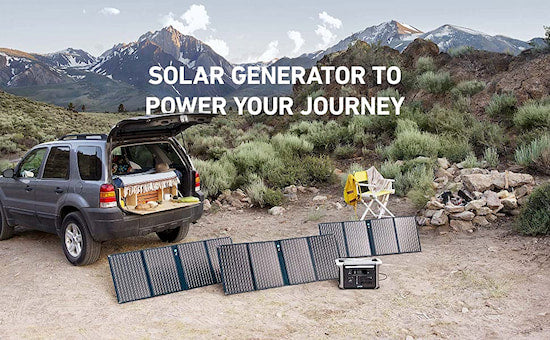
- Flashlight or headlamp
A headlamp or flashlight is an essential piece of camping gear that can enhance safety, convenience, and enjoyment during your camping trip. With a flashlight or headlamp, it’s easier to perform tasks in low-light conditions, such as cooking, reading, or setting up your tent. It also helps you identify potential hazards during camping, like obstacles or wildlife. In emergency situations, a headlamp or flashlight can also be used to signal for help.
Tips for Camping in Yellowstone National Park
- Remember to make online reservations in advance for popular campgrounds. It is difficult to find a suitable campsite without making an appointment during the peak season.
- When choosing the sites and building your camp, avoid beehives and ant nests to prevent poisonous insects from biting your body.
- It’s important to complete camp before dark.
- Wear appropriate footwear and protect your feet during camping.
- The weather can be unpredictable in the park, with temperatures that fluctuate greatly from day to night and from season to season. Therefore, visitors should be prepared for all types of weather. Be sure to bring thick clothes to wear in the morning and evening.
- Choose a sleeping bag that is suitable for sub-zero temperatures. It is also recommended to wear a cotton hat to sleep to keep your head warm.
- Yellowstone National Park is home to a wide variety of wildlife, including bears, wolves, and bison. Be sure to check that no food and water is left outside before going to sleep. Put foods or any scented stuff in sealed boxes or lockers, for it may attract wild animals.
- Dump stations are only available at specific campgrounds. If your campground provides no dump station, you should pack out all trash when leaving.
- Campfires are allowed in Yellowstone National Park. However, it is restricted within the established fire rings of designated campgrounds. Andthe lighted campfire must be attended to all the time.
- Sugary or alcoholic drinks can actually increase dehydration, so it's best to avoid them while camping. Stick to water or other hydrating drinks such as sports drinks or coconut water.
Final Thoughts
Yellowstone National Park is a wonderful place for a camping trip. Campers will have a wide selection of places where they can see valleys, mountains, lakes, rivers and wildlife. Other activities like cooking, living in the RV or visiting museums could also be fun. If you have already decided to camp in Yellowstone, be sure to bring the essentials mentioned above such as a sleeping pad, a power generator, and a flashlight. Also, remember the tips as they will help you stay safe and comfortable during your camping in Yellowstone.
Be the First to Know
Save Up to 30% Off
Already signed up? Log in here.



